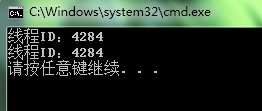步骤:
1、创建一个类似于void CALLBACK TimeoutCallBack(PTP_CALLBACK_INSTANCE pInstance, PVOID pvContext, PTP_TIMER pcbe)的函数
2、CreateThreadpoolTimer
3、SetThreadpoolTimer
4、CloseThreadpoolTimer
理解:
其实就是相当于一个可等待的内核对象,不可在实现上,采用了线程池的技术。
代码:
#include <iostream>
#include <afx.h>
using namespace std;
void CALLBACK TimeoutCallBack(
PTP_CALLBACK_INSTANCE pInstance,
PVOID pvContext,
PTP_TIMER pcbe)
{
cout << "线程ID:" << GetCurrentThreadId() << endl;
}
void main()
{
PTP_TIMER pTimer = CreateThreadpoolTimer(TimeoutCallBack, NULL, NULL);
SYSTEMTIME st;
FILETIME ftLocal, ftUTC;
LARGE_INTEGER liUTC;
st.wYear = 2013;
st.wMonth = 9;
st.wDay = 26;
st.wDayOfWeek = 0;
st.wHour = 12;
st.wMinute = 46;
st.wSecond = 0;
st.wMilliseconds = 0;
SystemTimeToFileTime(&st, &ftLocal);
LocalFileTimeToFileTime(&ftLocal, &ftUTC);
liUTC.LowPart = ftUTC.dwLowDateTime;
liUTC.HighPart = ftUTC.dwHighDateTime;
SetThreadpoolTimer(pTimer, &ftUTC, 1000, 0);
Sleep(2000);
WaitForThreadpoolTimerCallbacks(pTimer, TRUE);
CloseThreadpoolTimer(pTimer);
}
结果:
